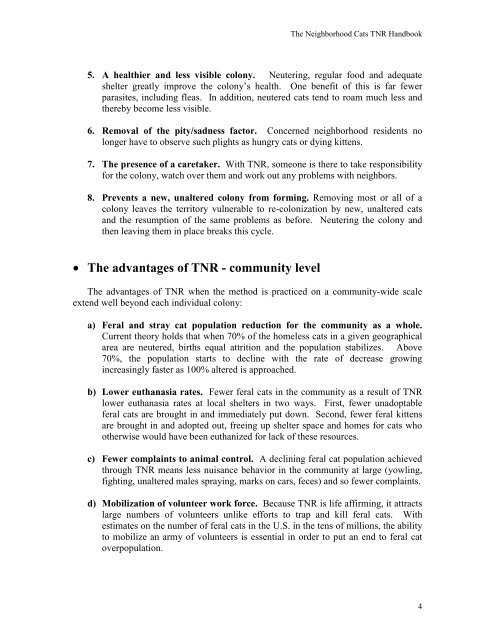You also want an ePaper? Increase the reach of your titles
YUMPU automatically turns print PDFs into web optimized ePapers that Google loves.
The <strong>Neighborhood</strong> <strong>Cats</strong> <strong>TNR</strong> <strong>Handbook</strong><br />
5. A healthier and less visible colony. Neutering, regular food and adequate<br />
shelter greatly improve the colony’s health. One benefit of this is far fewer<br />
parasites, including fleas. In addition, neutered cats tend to roam much less and<br />
thereby become less visible.<br />
6. Removal of the pity/sadness factor. Concerned neighborhood residents no<br />
longer have to observe such plights as hungry cats or dying kittens.<br />
7. The presence of a caretaker. With <strong>TNR</strong>, someone is there to take responsibility<br />
for the colony, watch over them and work out any problems with neighbors.<br />
8. Prevents a new, unaltered colony from forming. Removing most or all of a<br />
colony leaves the territory vulnerable to re-colonization by new, unaltered cats<br />
and the resumption of the same problems as before. Neutering the colony and<br />
then leaving them in place breaks this cycle.<br />
• The advantages of <strong>TNR</strong> - community level<br />
The advantages of <strong>TNR</strong> when the method is practiced on a community-wide scale<br />
extend well beyond each individual colony:<br />
a) Feral and stray cat population reduction for the community as a whole.<br />
Current theory holds that when 70% of the homeless cats in a given geographical<br />
area are neutered, births equal attrition and the population stabilizes. Above<br />
70%, the population starts to decline with the rate of decrease growing<br />
increasingly faster as 100% altered is approached.<br />
b) Lower euthanasia rates. Fewer feral cats in the community as a result of <strong>TNR</strong><br />
lower euthanasia rates at local shelters in two ways. First, fewer unadoptable<br />
feral cats are brought in and immediately put down. Second, fewer feral kittens<br />
are brought in and adopted out, freeing up shelter space and homes for cats who<br />
otherwise would have been euthanized for lack of these resources.<br />
c) Fewer complaints to animal control. A declining feral cat population achieved<br />
through <strong>TNR</strong> means less nuisance behavior in the community at large (yowling,<br />
fighting, unaltered males spraying, marks on cars, feces) and so fewer complaints.<br />
d) Mobilization of volunteer work force. Because <strong>TNR</strong> is life affirming, it attracts<br />
large numbers of volunteers unlike efforts to trap and kill feral cats. With<br />
estimates on the number of feral cats in the U.S. in the tens of millions, the ability<br />
to mobilize an army of volunteers is essential in order to put an end to feral cat<br />
overpopulation.<br />
4


